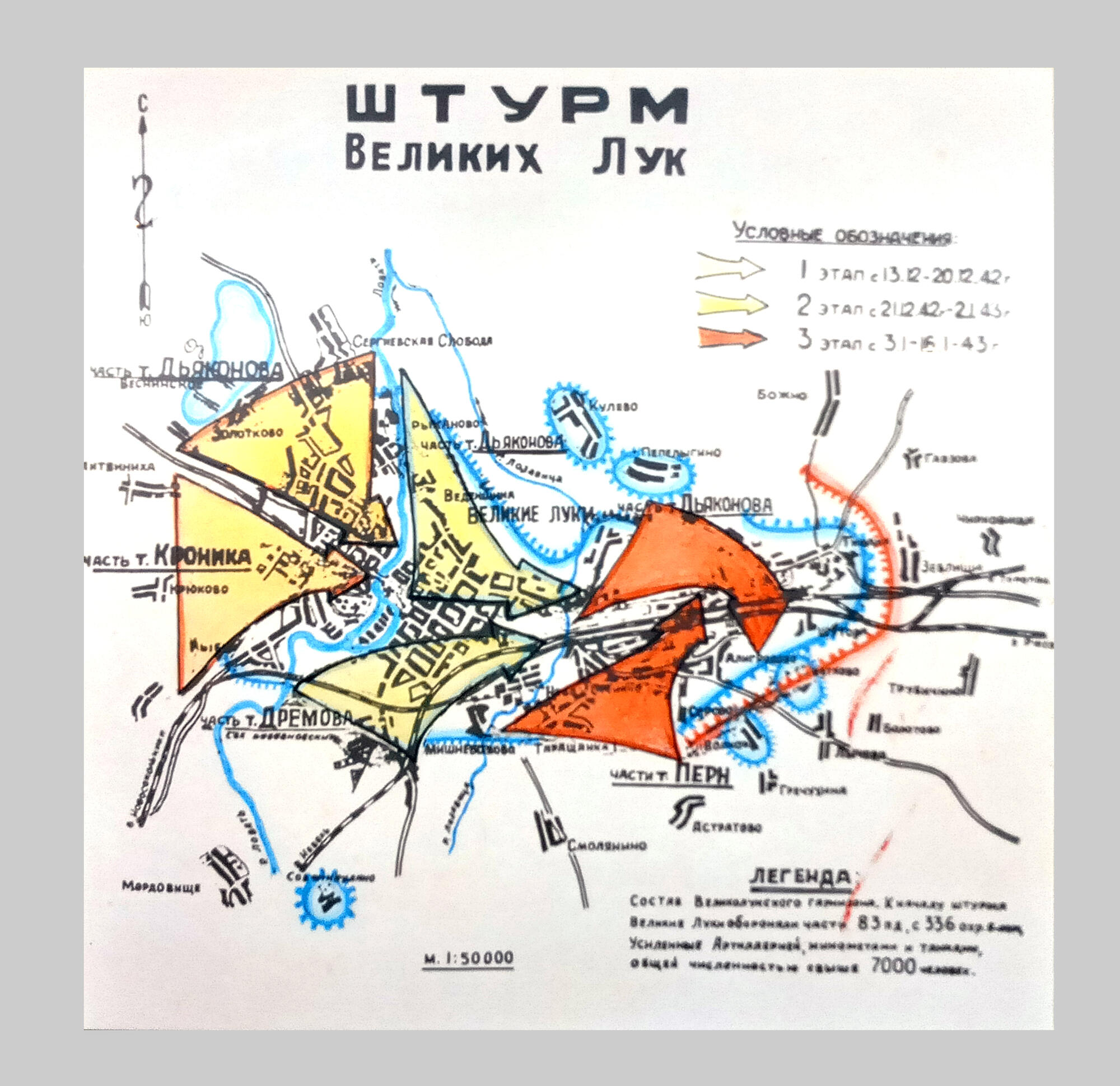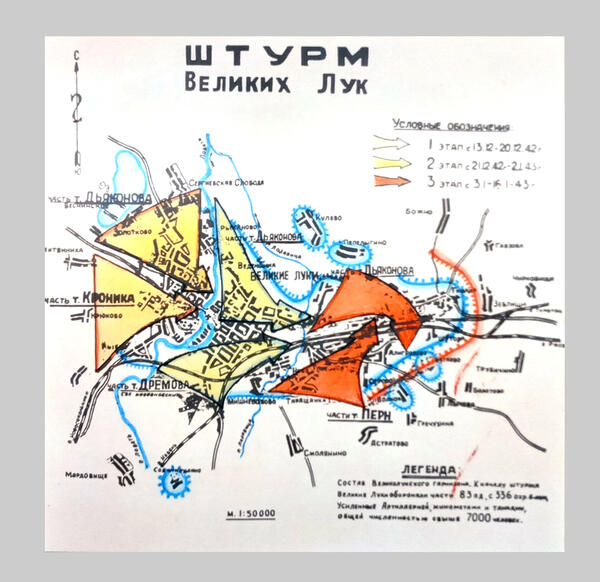The assault plan kept in the museum provides a complete picture of the Velikiye Luki offensive operation. From November 25, 1942, until January 20, 1943, the assault was carried out by the 3rd Shock Army of the Kalinin Front with the support of the 3rd Air Army.
The plan of the operation was as follows: the 5th Guards Rifle Corps was to deliver the main blow, break through the enemy defenses south of VelIkiye LUki and move west to NovosokOlniki. Three Rifle Divisions—381st, 257th, and 357th—were to advance from the north and south, bypass the city and block the German garrison in it. The 2nd Mechanized Corps remained in reserve and was ready to act depending on how the operation would develop.
During the offensive, the troops of the 3rd Shock Army advanced 24 km in depth and 50 kilometers along the front. They recaptured most of the city on January 1, 1943. Already on November 28–29, Soviet troops managed to close the ring around the city and encircle about 8,000–9,000 Nazi troops. The headquarters of the 3rd Shock Army had rather complete information about the size of the encircled group and the nature of its defensive fortifications.
The assault on the city began on December 13, 1942. Fierce street fighting broke out between the Soviet and German troops. On December 15, the Soviet command suggested that the German garrison cease resistance, lay down their arms and surrender. For this purpose, two envoys were sent to the headquarters of the German troops: Senior Lieutenant Mikhail Shishkin and Lieutenant Ivan Smirnov. This visit was the first such act since the beginning of the war on the Eastern Front.
Von Sass, the commander of the garrison, refused to negotiate. By January 1, 1943, the city was completely in the hands of the Soviet troops. Only two separate enemy groups continued to resist: one in the fortress, and one in the area of the railway junction. On January 16, the Soviet troops completely surrounded and defeated the German garrison in Velikiye Luki. By noon of the same day, only one center of resistance remained under the control of the enemy: the defense headquarters, headed by Lieutenant Colonel von Sass himself.
At 3:30 pm a special detachment of the 249th Division broke into the basement and captured 52 soldiers and officers, including the lieutenant colonel himself. The German garrison of Velikiye Luki completely ceased to exist.
The Velikiye Luki offensive operation lasted almost two months. During this time, the Soviet troops, having paid the price of more than 30,000 lives, freed about 650 km2 from the enemy, drove the enemy out of Velikiye Luki and fulfilled the main task of the operation: they diverted the attention of ten German divisions and did not allow the transfer of additional forces to StalingrAd. The Germans lost more than 57,000 soldiers.
The plan of the operation was as follows: the 5th Guards Rifle Corps was to deliver the main blow, break through the enemy defenses south of VelIkiye LUki and move west to NovosokOlniki. Three Rifle Divisions—381st, 257th, and 357th—were to advance from the north and south, bypass the city and block the German garrison in it. The 2nd Mechanized Corps remained in reserve and was ready to act depending on how the operation would develop.
During the offensive, the troops of the 3rd Shock Army advanced 24 km in depth and 50 kilometers along the front. They recaptured most of the city on January 1, 1943. Already on November 28–29, Soviet troops managed to close the ring around the city and encircle about 8,000–9,000 Nazi troops. The headquarters of the 3rd Shock Army had rather complete information about the size of the encircled group and the nature of its defensive fortifications.
The assault on the city began on December 13, 1942. Fierce street fighting broke out between the Soviet and German troops. On December 15, the Soviet command suggested that the German garrison cease resistance, lay down their arms and surrender. For this purpose, two envoys were sent to the headquarters of the German troops: Senior Lieutenant Mikhail Shishkin and Lieutenant Ivan Smirnov. This visit was the first such act since the beginning of the war on the Eastern Front.
Von Sass, the commander of the garrison, refused to negotiate. By January 1, 1943, the city was completely in the hands of the Soviet troops. Only two separate enemy groups continued to resist: one in the fortress, and one in the area of the railway junction. On January 16, the Soviet troops completely surrounded and defeated the German garrison in Velikiye Luki. By noon of the same day, only one center of resistance remained under the control of the enemy: the defense headquarters, headed by Lieutenant Colonel von Sass himself.
At 3:30 pm a special detachment of the 249th Division broke into the basement and captured 52 soldiers and officers, including the lieutenant colonel himself. The German garrison of Velikiye Luki completely ceased to exist.
The Velikiye Luki offensive operation lasted almost two months. During this time, the Soviet troops, having paid the price of more than 30,000 lives, freed about 650 km2 from the enemy, drove the enemy out of Velikiye Luki and fulfilled the main task of the operation: they diverted the attention of ten German divisions and did not allow the transfer of additional forces to StalingrAd. The Germans lost more than 57,000 soldiers.



